
views
Creating a Makeshift Tent

Have the right materials. To build a makeshift tent, you’ll need rope or a line of some kind to string between two trees, a tarp or poncho to hang on the rope, and something to anchor the tarp to the ground. If you don’t have any rope or string, you can use a strong branch propped between the two trees several feet above the ground. If you are using a branch in place of a rope, you will need some way to keep it firmly attached to your trees, such as a notch in the tree.

Find a good location. A makeshift tent will require two sturdy trees located a few feet apart. The trees should be far enough so you can comfortably lay down between them, but not so far apart that you cannot tie your rope between them without running out. You will be laying down with your head at one tree and your feet at the other--not with your shoulders between the trees.
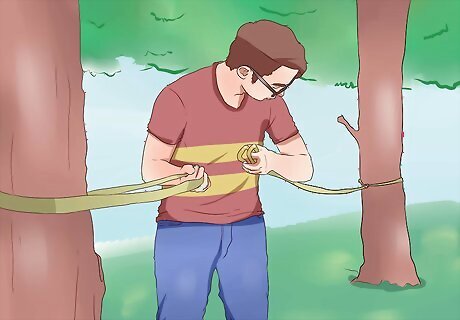
Tie a line between the two trees. A clove hitch is a good knot to secure the rope to each tree and prevent slipping. Make sure the rope is taught and low to the ground. You want as little space as possible under the tarp to help keep in warmth. If you are using a stick or branch, make sure you secure it to the tree as low to the ground as possible to trap heat. If you are in snowy winter weather, you can secure the rope a little higher up the tree to create steeper walls on your tent. The steeper walls will let the snow fall off more easily. Collected snow is heavy, and your tent could collapse if too much accumulates. Make sure that your rope isn’t causing any lasting damage to the tree.

Hang your tarp over the line. Your support brace (the rope or branch) should be low enough so that that tarp reaches the ground on both sides. Make sure to stretch it tightly to keep extra air out of your sleeping space. Spread the edges as wide apart as possible to keep the tarp taut.

Secure the edges of your tarp. Make sure your tarp is held on to the ground. Heavy objects like large rocks or logs should be enough to hold it in place If you have additional rope and some stakes (or a few sharpened sticks), you can use these items to secure a tarp with grommets. Run some rope through each grommet to pull the tarp taught, and warp around stakes you have driven into the ground. If you don’t have any rope, you can drive the stakes right through the grommets.
Building a Lean-to

Look for a good building site. A lean-to is a simple outdoor construction, and only requires something for branches or a tarp to “lean” against. Long boulders or fallen trees can be ideal for acting as a horizontal brace to lean other sticks or brush against. Any large, immobile object can work. If you have a tarp and some rope, you can make a lean-to between two trees.
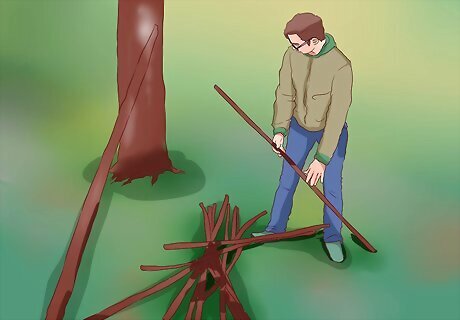
Find sticks to lean against the horizontal brace. These sticks should be somewhat sturdy, as they will form a side of the shelter. Be sure that there is enough room between them, the brace, and the ground for you to crawl inside comfortably. You should have just enough space under your brace for you and anyone else with you to crawl into. The more extra space you have there, the harder it will be to keep yourself warm. If you can, keep the lean-to’s profile low to ground. This will help keep you further out of the line of wind, and won’t attract attention. This is helpful if you are trying to avoid detection, or otherwise stay out of sight.
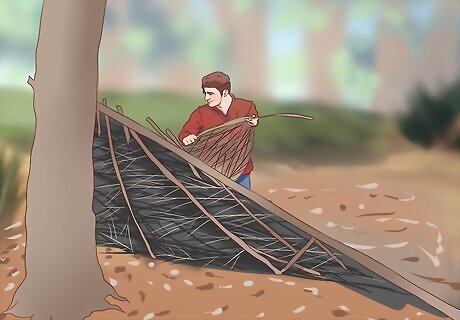
Pile small debris over the frame. You can use leaves, grass, and moss to build a wall on the outside of your lean-to. These will provide further insulation and protection from the elements. Nearly any small forest debris will work. Just make sure to pack it tightly on the wall frame so it won't blow away readily. You can pile more of this debris on the floor and interior of your lean-to to provide extra insulation.
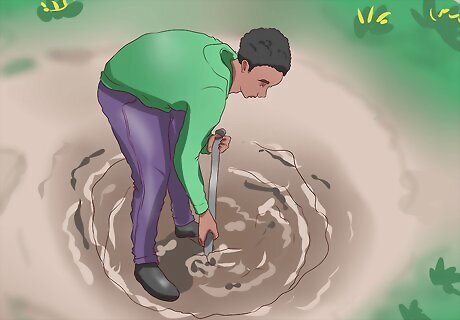
Dig a pit for a fire. Another way to help keep warm under your lean-to is to build a fire. Dig a small hole for your fire on the open side of your lean-to. Be sure to keep it a safe distance from any underbrush and your shelter. If you do build a fire, keep an eye on it at all times. If you want to go to sleep, make sure someone will be able to stay up to watch it, or just put it out completely. Put a ring of stones around the fire pit to help rein it in.
Making a Debris Hut

Find a good location. You’ll need a tree stump, or a tree with a low crook that you can comfortably lodge a branch into. In addition, you’ll need to be in an area with lots of sticks and debris to cover your frame. Make sure you are away from falling branches or other hazards. Your debris hut will trap heat and keep you warm, but won’t protect well against falling objects.
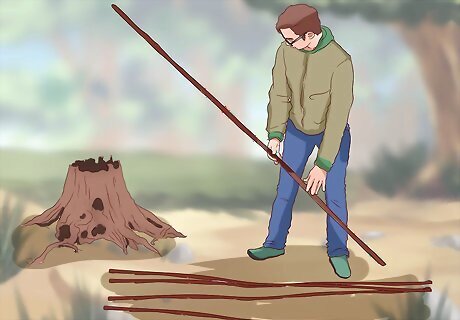
Prop a log or a stick against the stump. You’ll want a long piece, probably close to 8 feet (2.4 m), that is sturdy enough to support your weight without breaking. The space underneath this branch between where it rests on the tree and sits on the ground should be just large enough for you to fit in.

Set up ribbing sticks. Find long sticks to create the frame, or ribbing, of your hut. These sticks should be long enough to lean against the horizontal branch. As you get further away from the tree stump, they will get shorter. These sticks only need to lean against the branch, but if you have rope or twine you can bind them together for a little more stability. Make sure you leave space between two of the ribs for an entranceway to your hut. The ribbing sticks need to be spread widely enough apart so that you can fit underneath them. About 6 inches (15 cm) on either side of your body is a good rule to follow. Additionally, they should be steep enough to let water or snow run off.
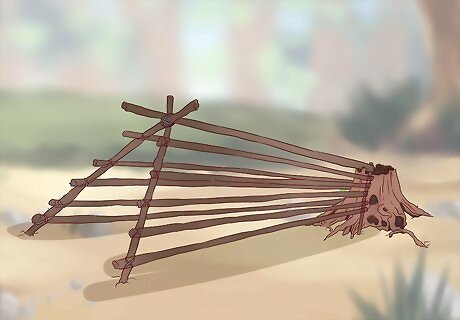
Fill out the frame. After you have set up this frame, add more sticks perpendicularly on top of this wall frame to create latticework. This will give you something to pile debris on without having it fall on top of you while sleeping. If you need to, lash the sticks to the frame with string.
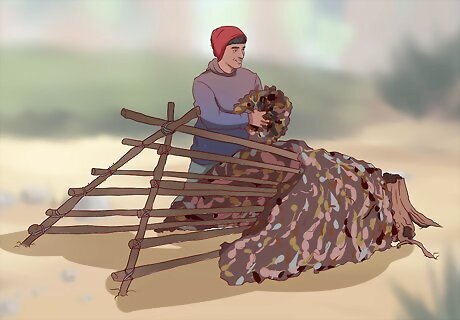
Pile debris on the frame. This will be any natural material you can find nearby, so leaves, grass, or pine needles. Ideally your debris layer will be 3 feet (0.91 m) thick to provide solid insulation. Thicker is always better. Just remember to leave an entranceway for you to get in. After you finish the outer layer, build another insulation layer on the inside walls of your frame. This interior insulation should be about 6 inches thick. You want your debris to be as dry as possible. If you don’t have enough dry material to cover the whole hut, make sure the driest and softest material is inside your hut, closest to your body. If you are in deep winter, or an Arctic-type environment where there is little debris, you can pile thick snow on the frame instead. The snow needs to stay cold so it doesn't melt, potentially soaking your stuff, or collapsing on top of you.
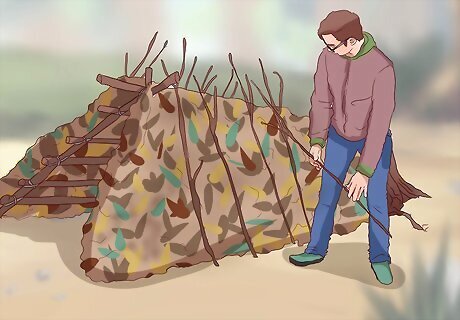
Add more branches to the outside. Once you have packed your debris tightly on the frame, lay a few more branches on top of your hut. This will help keep your insulation material from blowing away in strong winds. Again, if the branches are falling off, use string to secure them to the frame. You will need to pass the string through the various layers of your hut's wall.

Block the entrance. Once you are snug inside your hut, make sure you close up the entrance to minimize air circulation and trap heat. Additional debris can be harder to gather together behind you, so you may consider something like a shirt stuffed with leaves. Another good alternative is a large hiking backpack. It will be big enough to block the entrance, plus you will free up extra space inside the hut.




















Comments
0 comment